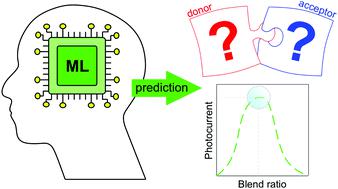当前位置:
X-MOL 学术
›
Energy Environ. Sci.
›
论文详情
Our official English website, www.x-mol.net, welcomes your feedback! (Note: you will need to create a separate account there.)
Predicting the photocurrent–composition dependence in organic solar cells
Energy & Environmental Science ( IF 32.5 ) Pub Date : 2021-1-7 , DOI: 10.1039/d0ee02958k Xabier Rodríguez-Martínez 1, 2, 3, 4 , Enrique Pascual-San-José 1, 2, 3, 4 , Zhuping Fei 5, 6, 7, 8, 9 , Martin Heeney 5, 6, 7, 8, 9 , Roger Guimerà 4, 10, 11, 12, 13 , Mariano Campoy-Quiles 1, 2, 3, 4
Energy & Environmental Science ( IF 32.5 ) Pub Date : 2021-1-7 , DOI: 10.1039/d0ee02958k Xabier Rodríguez-Martínez 1, 2, 3, 4 , Enrique Pascual-San-José 1, 2, 3, 4 , Zhuping Fei 5, 6, 7, 8, 9 , Martin Heeney 5, 6, 7, 8, 9 , Roger Guimerà 4, 10, 11, 12, 13 , Mariano Campoy-Quiles 1, 2, 3, 4
Affiliation

|
The continuous development of improved non-fullerene acceptors and deeper knowledge of the fundamental mechanisms governing performance underpin the vertiginous increase in efficiency witnessed by organic photovoltaics. While the influence of parameters like film thickness and morphology are generally understood, what determines the strong dependence of the photocurrent on the donor and acceptor fractions remains elusive. Here we approach this problem by training artificial intelligence algorithms with self-consistent datasets consisting of thousands of data points obtained by high-throughput evaluation methods. Two ensemble learning methods are implemented, namely a Bayesian machine scientist and a random decision forest. While the former demonstrates large descriptive power to complement the experimental high-throughput screening, the latter is found to predict with excellent accuracy the photocurrent–composition phase space for material systems outside the training set. Interestingly, we identify highly predictive models that only employ the materials band gaps, thus largely simplifying the rationale of the photocurrent–composition space.
中文翻译:

预测有机太阳能电池中的光电流组成依赖性
改进的非富勒烯受体的不断发展以及对性能支配的基本机制的深入了解,为有机光伏技术带来了效率的显着提高。虽然通常理解诸如膜厚度和形态的参数的影响,但是确定光电流对供体和受体分数的强烈依赖性的决定性因素仍然不清楚。在这里,我们通过使用由高通量评估方法获得的数千个数据点组成的自洽数据集训练人工智能算法来解决此问题。实现了两种集成学习方法,即贝叶斯机器科学家和随机决策森林。前者显示出强大的描述能力,可以补充实验性高通量筛选,后者被发现可以非常精确地预测训练集以外的材料系统的光电流组成相空间。有趣的是,我们确定了仅使用材料带隙的高预测性模型,从而大大简化了光电流组成空间的原理。
更新日期:2021-01-13
中文翻译:

预测有机太阳能电池中的光电流组成依赖性
改进的非富勒烯受体的不断发展以及对性能支配的基本机制的深入了解,为有机光伏技术带来了效率的显着提高。虽然通常理解诸如膜厚度和形态的参数的影响,但是确定光电流对供体和受体分数的强烈依赖性的决定性因素仍然不清楚。在这里,我们通过使用由高通量评估方法获得的数千个数据点组成的自洽数据集训练人工智能算法来解决此问题。实现了两种集成学习方法,即贝叶斯机器科学家和随机决策森林。前者显示出强大的描述能力,可以补充实验性高通量筛选,后者被发现可以非常精确地预测训练集以外的材料系统的光电流组成相空间。有趣的是,我们确定了仅使用材料带隙的高预测性模型,从而大大简化了光电流组成空间的原理。



























 京公网安备 11010802027423号
京公网安备 11010802027423号